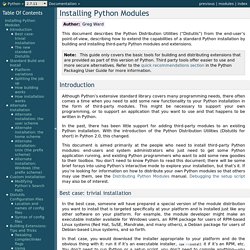

Installing Python Modules. This document describes the Python Distribution Utilities (“Distutils”) from the end-user’s point-of-view, describing how to extend the capabilities of a standard Python installation by building and installing third-party Python modules and extensions.

Introduction Although Python’s extensive standard library covers many programming needs, there often comes a time when you need to add some new functionality to your Python installation in the form of third-party modules. This might be necessary to support your own programming, or to support an application that you want to use and that happens to be written in Python. In the past, there has been little support for adding third-party modules to an existing Python installation. With the introduction of the Python Distribution Utilities (Distutils for short) in Python 2.0, this changed. Best case: trivial installation Of course, things will not always be that easy. The new standard: Distutils Standard Build and Install Platform variations Notes: Api example code: custom_projection_example.py. Python Extension Packages for Windows - Christoph Gohlke.
By Christoph Gohlke, Laboratory for Fluorescence Dynamics, University of California, Irvine.

This page provides 32- and 64-bit Windows binaries of many scientific open-source extension packages for the official CPython distribution of the Python programming language. The files are unofficial (meaning: informal, unrecognized, personal, unsupported, no warranty, no liability, provided "as is") and made available for testing and evaluation purposes. If downloads fail reload this page, enable JavaScript, disable download managers, disable proxies, clear cache, and use Firefox. Please only download files manually as needed. Most binaries are built from source code found on PyPI or in the projects public revision control systems. Refer to the documentation of the individual packages for license restrictions and dependencies. Use pip version 8 or newer to install the downloaded .whl files. Install numpy+mkl before other packages that depend on it. Build Environment. Python: 50 modules for all needs. Learn Python The Hard Way, 2nd Edition — Learn Python The Hard Way, 2nd Edition.
Iterators, Iterables, and Generators! Oh, my! By: Mark Mruss Note: This article was first published the January 2008 issue of Python Magazine Iterators, iterables, and generators are features handled so wall by Python that people programming in other languages cannot help but drool over.

Fortunately for us, creating iterators, iterables and generators is a relatively simple task. This article introduces the concepts of iterators, iterables, and generators and illustrates how easy it is to add them to your code. Introduction In this article I’m going to introduce three related Python features: iterators, iterables, and generators. Note: Classes that define the __getitem__ function are also considered iterables, but since that falls outside the scope of this article, it will not be covered here. In this tutorial, I will begin by discussing iterators, the most basic concept. Iteration in Python Iterators objects are used in Python in order to iterate over an objects data. My_list = [1,2,3] for num in my_list: print num An initial example [1]